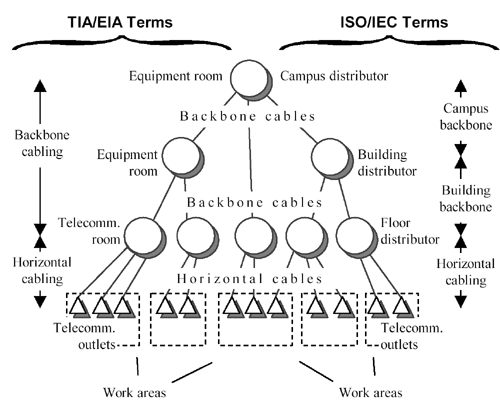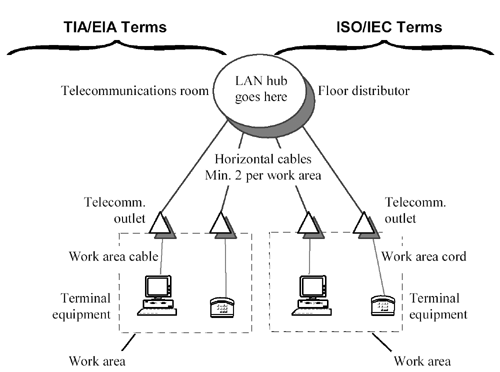Generic Cabling Architecture
Both building-cabling standards TIA/EIA 568-B.1-2001 and ISO/IEC 11801:2002 define generic cabling for use in commercial buildings and between commercial buildings in a campus setting. These two standards pertain to data and telephone cabling, but not to wiring for power, HVAC, or building control systems.
Generic cabling uses a star-wiring topology (Figure 7.1). In the star topology, cables fan out from a single location to individual work areas.
Figure 7.1. TIA/EIA and ISO/IEC use slightly different terms to describe hierarchical building cabling.

Cables running between equipment rooms and from equipment rooms to telecommunications rooms are called backbone cables . [61] In the generic cabling plan, these cables establish hierarchical connections between telecommunications closets. Backbone cables are also called vertical cables in reference to how they run between floors in tall buildings.
[61] This description of the generic wiring architecture uses TIA/EIA terminology.
Cables running from the telecommunications rooms to the work areas are called horizontal cables . The word horizontal refers to the way users normally install such cables, running them along floors and ceilings. Horizontal cables are used for both computer and telephone communications.
There are more choices for backbone cables than for horizontal cables. For example, backbone cables often employ fiber, whereas horizontal cables usually do not. The plethora of choices makes it difficult for customers to choose the right backbone cabling for the future, and it makes it difficult for system manufacturers to decide what to support.
Fortunately, most users do not view backbone cabling as a permanent choice. Unlike horizontal cabling, typical installations do not have very many backbone cables. Backbone cables run only between closets, whereas horizontal cables run to every work area. Furthermore, backbone cables terminate in telecommunications and equipment rooms, not in the work area where they have to look pretty. Both factors make backbone cables easier to replace than horizontal cables. The difference in effort required to replace backbone cabling compared to horizontal cabling may be a factor of a hundred or more.
A weird backbone cabling requirement is a sales obstacle to be overcome .
A weird horizontal cabling requirement is a wooden stake in the heart of your project .
Horizontal cabling is the most widely deployed, highest-volume element of the building-cabling architecture. Horizontal cabling components are available at rock-bottom prices from a wide variety of sources. If you design your system to work on standard horizontal cabling, you will find a ready market of customers who already have this cabling installed and a large pool of trained technicians who know how to install and maintain it. Standard horizontal cabling is the best choice for most interconnections at lengths from 3 m to 100 m.
While the generic cabling standards leave lots of leeway in the definition of backbone cabling, they leave very little slack in the definition of the horizontal connections. This is important because there are so many more horizontal connections in a building than backbone connections.
A horizontal connection consists of no more than 100 m of cable, independent of cable type. The standards permit no bridges, taps, or Y connections in a horizontal cable. Each horizontal cable must be a dedicated, point-to-point connection. Two horizontal cables serve each work area (Figure 7.2).
Figure 7.2. Two horizontal cables serve each work area.

TIA/EIA 568-B.1-2001 and ISO/IEC 11801:2002 both specify (or point to specifications for) all the cables, connectors, jumpers , and cords necessary for interconnecting equipment. These two standards then roll up the entire signal-to-noise budget for various combinations of interconnections, showing how the cable, connector, jumper , and cord specifications each relate to the whole budget.
The beauty of these cable standards is the way they break each interconnection into three levels of testable specifications: a cable , a permanent link , and a channel (Figure 7.3).
Figure 7.3. Cable manufacturers care about cable specs , installers care about permanent link specs, and system manufacturers care about channel specs. Generic cabling standards roll together all three differing views.

Cable ” One continuous piece of balanced transmission media. People who manufacture cables are interested only in this portion of the specifications.
Permanent link ” Extends from the work area telecommunications outlet to the permanent termination point of the horizontal cabling in the telecommunications room. It may include a short section of cabling with an intermediate transition point designed to facilitate layout of open -air offices using under-carpet cabling or cabling built into cubicle walls. People who install building cabling are expected to properly install and test all permanent links.
Channel ” An entire connection, starting at the end of the telecommunications equipment cable and completing at the bitter end of the work area cable. People who use building cabling or who manufacture equipment that interfaces to building cabling care about the performance of the whole channel.
TIA/EIA and ISO/IEC cabling standards differ , but less and less as time passes . The most important point is that the horizontal channels for both standards include support for the most popular cable type ”category 5e 100- W balanced cabling. Some of the remaining differences are called out in Table 7.1
Table 7.1. Popular Cables Recognized for Use as Horizontal Cabling
|
TIA/EIA 568-B.1-2001 |
ISO/IEC 11801:2002 |
||
|---|---|---|---|
|
Cable Type [1] , [2] |
Pairs or strands [3] |
Cable Type |
Pairs or strands |
|
100- W category 5, 5e, or 6 balanced cabling |
4 |
100- W category 5, 5e, 6, or 7 balanced cabling |
2 or 4 |
|
62.5/125- m m multimode fiber |
2 |
62.5/125- m m multimode fiber |
2 |
|
50/125- m m multimode fiber |
2 |
50/125- m m multimode fiber |
2 |
[1] NOTE (1) ”Category 3 cables are still recognized by both standards but no longer widely available in the market. Category 5 and 5e cables perform better and cost no more.
[2] NOTE (2) ”150- W STP-A is still recognized by both standards but no longer widely available in the market. It may be dropped from future versions of the generic wiring standards.
[3] NOTE (3) ”Pairs of 100- W balanced cable or strands of fiber.
POINTS TO REMEMBER
- Horizontal cabling is the most widely deployed, highest-volume element of the building-cabling architecture.
- New buildings in North America provide two outlets in every work area, with four-pair, 100- W UTP, category 5 or better cabling to both outlets.
- Backbone cables are mostly a mix of category 5 cables, multimode fiber (62.5- m m or 50- m m), and some single-mode fiber.
- A weird backbone cabling requirement is a sales obstacle to be overcome. A weird horizontal cabling requirement is a wooden stake in the heart of your project.
Fundamentals
- Impedance of Linear, Time-Invariant, Lumped-Element Circuits
- Power Ratios
- Rules of Scaling
- The Concept of Resonance
- Extra for Experts: Maximal Linear System Response to a Digital Input
Transmission Line Parameters
- Transmission Line Parameters
- Telegraphers Equations
- Derivation of Telegraphers Equations
- Ideal Transmission Line
- DC Resistance
- DC Conductance
- Skin Effect
- Skin-Effect Inductance
- Modeling Internal Impedance
- Concentric-Ring Skin-Effect Model
- Proximity Effect
- Surface Roughness
- Dielectric Effects
- Impedance in Series with the Return Path
- Slow-Wave Mode On-Chip
Performance Regions
- Performance Regions
- Signal Propagation Model
- Hierarchy of Regions
- Necessary Mathematics: Input Impedance and Transfer Function
- Lumped-Element Region
- RC Region
- LC Region (Constant-Loss Region)
- Skin-Effect Region
- Dielectric Loss Region
- Waveguide Dispersion Region
- Summary of Breakpoints Between Regions
- Equivalence Principle for Transmission Media
- Scaling Copper Transmission Media
- Scaling Multimode Fiber-Optic Cables
- Linear Equalization: Long Backplane Trace Example
- Adaptive Equalization: Accelerant Networks Transceiver
Frequency-Domain Modeling
- Frequency-Domain Modeling
- Going Nonlinear
- Approximations to the Fourier Transform
- Discrete Time Mapping
- Other Limitations of the FFT
- Normalizing the Output of an FFT Routine
- Useful Fourier Transform-Pairs
- Effect of Inadequate Sampling Rate
- Implementation of Frequency-Domain Simulation
- Embellishments
- Checking the Output of Your FFT Routine
Pcb (printed-circuit board) Traces
- Pcb (printed-circuit board) Traces
- Pcb Signal Propagation
- Limits to Attainable Distance
- Pcb Noise and Interference
- Pcb Connectors
- Modeling Vias
- The Future of On-Chip Interconnections
Differential Signaling
- Differential Signaling
- Single-Ended Circuits
- Two-Wire Circuits
- Differential Signaling
- Differential and Common-Mode Voltages and Currents
- Differential and Common-Mode Velocity
- Common-Mode Balance
- Common-Mode Range
- Differential to Common-Mode Conversion
- Differential Impedance
- Pcb Configurations
- Pcb Applications
- Intercabinet Applications
- LVDS Signaling
Generic Building-Cabling Standards
- Generic Building-Cabling Standards
- Generic Cabling Architecture
- SNR Budgeting
- Glossary of Cabling Terms
- Preferred Cable Combinations
- FAQ: Building-Cabling Practices
- Crossover Wiring
- Plenum-Rated Cables
- Laying Cables in an Uncooled Attic Space
- FAQ: Older Cable Types
100-Ohm Balanced Twisted-Pair Cabling
- 100-Ohm Balanced Twisted-Pair Cabling
- UTP Signal Propagation
- UTP Transmission Example: 10BASE-T
- UTP Noise and Interference
- UTP Connectors
- Issues with Screening
- Category-3 UTP at Elevated Temperature
150-Ohm STP-A Cabling
- 150-Ohm STP-A Cabling
- 150- W STP-A Signal Propagation
- 150- W STP-A Noise and Interference
- 150- W STP-A: Skew
- 150- W STP-A: Radiation and Safety
- 150- W STP-A: Comparison with UTP
- 150- W STP-A Connectors
Coaxial Cabling
- Coaxial Cabling
- Coaxial Signal Propagation
- Coaxial Cable Noise and Interference
- Coaxial Cable Connectors
Fiber-Optic Cabling
- Fiber-Optic Cabling
- Making Glass Fiber
- Finished Core Specifications
- Cabling the Fiber
- Wavelengths of Operation
- Multimode Glass Fiber-Optic Cabling
- Single-Mode Fiber-Optic Cabling
Clock Distribution
- Clock Distribution
- Extra Fries, Please
- Arithmetic of Clock Skew
- Clock Repeaters
- Stripline vs. Microstrip Delay
- Importance of Terminating Clock Lines
- Effect of Clock Receiver Thresholds
- Effect of Split Termination
- Intentional Delay Adjustments
- Driving Multiple Loads with Source Termination
- Daisy-Chain Clock Distribution
- The Jitters
- Power Supply Filtering for Clock Sources, Repeaters, and PLL Circuits
- Intentional Clock Modulation
- Reduced-Voltage Signaling
- Controlling Crosstalk on Clock Lines
- Reducing Emissions
Time-Domain Simulation Tools and Methods
- Ringing in a New Era
- Signal Integrity Simulation Process
- The Underlying Simulation Engine
- IBIS (I/O Buffer Information Specification)
- IBIS: History and Future Direction
- IBIS: Issues with Interpolation
- IBIS: Issues with SSO Noise
- Nature of EMC Work
- Power and Ground Resonance
Points to Remember
Appendix A. Building a Signal Integrity Department
Appendix B. Calculation of Loss Slope
Appendix C. Two-Port Analysis
- Appendix C. Two-Port Analysis
- Simple Cases Involving Transmission Lines
- Fully Configured Transmission Line
- Complicated Configurations
Appendix D. Accuracy of Pi Model
Appendix E. erf( )
Notes
EAN: N/A
Pages: 163
- Challenging the Unpredictable: Changeable Order Management Systems
- Intrinsic and Contextual Data Quality: The Effect of Media and Personal Involvement
- Healthcare Information: From Administrative to Practice Databases
- A Hybrid Clustering Technique to Improve Patient Data Quality
- Relevance and Micro-Relevance for the Professional as Determinants of IT-Diffusion and IT-Use in Healthcare
